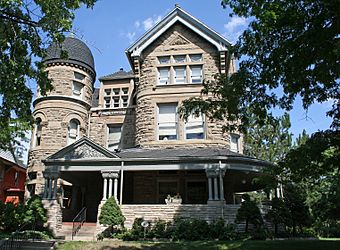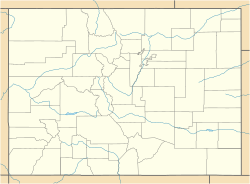Bailey House (Denver, Colorado) facts for kids
Quick facts for kids |
|
|
Bailey House
|
|

Bailey House
|
|
| Location | 1600 Ogden St., Denver, Colorado |
|---|---|
| Area | less than one acre |
| Built | 1889 |
| Architect | Lang, William |
| Architectural style | Queen Anne, Romanesque, Richardsonian Romanesque |
| NRHP reference No. | 78000840 |
| Added to NRHP | September 18, 1978 |
The Bailey House is a historic home located in Denver, Colorado. It was built in 1889 and designed by a famous architect named William A. Lang. This house was built for a person named Mr. G.W. Bailey. It is the largest home still standing that William Lang designed.
Contents
What Makes the Bailey House Special?
The Bailey House is a great example of old architecture. It shows off two main styles: Queen Anne and Richardsonian Romanesque. These styles were popular when the house was built.
Who Was William Lang?
William A. Lang was an important architect in Denver. He lived from 1846 to 1897. He worked in Denver from 1885 to 1893. He designed many buildings during that time. The Bailey House is one of his most famous designs.
What Architectural Styles Does It Have?
The Bailey House combines different building styles. It has a mix of fancy details and strong, sturdy features.
Queen Anne Style
The house mainly uses the Queen Anne style. This style was very popular in the late 1800s. Queen Anne homes often have:
- A tall, pointed tower on a corner.
- Different textures, like brick and wood shingles.
- Asymmetrical shapes, meaning one side doesn't perfectly match the other.
- A "pinwheel plan," which means the rooms are arranged around a central point.
Richardsonian Romanesque Style
The Bailey House also has parts that look like the Richardsonian Romanesque style. This style is known for:
- Heavy stone or brick materials.
- Round arches over windows and doors.
- Strong, castle-like appearances.
You can see these elements in the materials and details of the Bailey House.
Why Is the Bailey House Important?
The Bailey House is important because it shows the history of architecture in Denver. It was added to the National Register of Historic Places on September 18, 1978. This means it is a special building that should be protected. It helps us understand how people lived and built homes over a hundred years ago.



